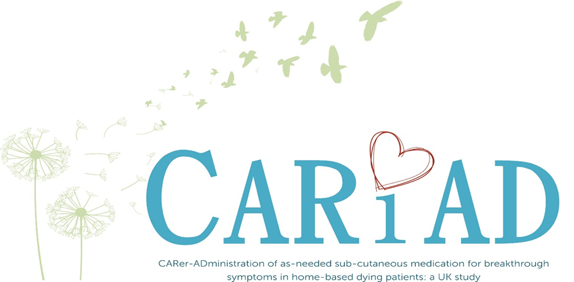 Findings from the CARiAD feasibility study published
Findings from the CARiAD feasibility study published
July 2020
Lay carer administration of as-needed subcutaneous medication to control symptoms in the last days of life of a loved one wishing to be at home when they die was acceptable and feasible, but low recruitment overall and low retention in the usual care group indicate the success of a future trial may be uncertain.
The CARiAD study explored the feasibility of testing the clinical effectiveness of the intervention of lay carer administration of as-needed subcutaneous medication for common breakthrough symptoms in people dying at home in the UK to inform the design of a future definitive trial.
Most people in the UK would prefer to die at home, but only half of them achieve this. This usually depends on having able and willing lay carers (family or friends) to help look after them. Once swallowing is not possible, medicine is given continually under the skin (syringe driver). If common problems such as pain, vomiting or agitation break through, health-care professionals attend to give extra doses. The wait for a health-care professional to arrive can be distressing.
In the UK, it is legal (but not routine) for lay carers to give needle-free subcutaneous injections themselves. We reworked an Australian carer education package for UK use. The best way to find out if this would work well is to do a randomised controlled trial. This is a test in which, at random, half of the people taking part receive ‘usual care’ and the other half receive the ‘new care’ or intervention. A pilot randomised controlled trial (a ‘test’ trial to see if a larger one is worth doing) was carried out to determine if lay carer injections were possible in the UK.
This new practice was safe, acceptable and welcomed. Carer confidence increased rapidly, symptom control was quicker and the interviews backed up these findings.
Recruitment was low owing to overstretched health-care professionals. Only certain families were picked. Dyads in the usual-care group often wished they were in the intervention group. Carers found it difficult to complete some of the questionnaires that were used to measure the effect of the intervention.
Therefore, uncertainty remains as to whether or not a full trial should proceed. Because the practice is already legal, some areas in the UK are already undertaking it. We plan to study what makes this practice possible or less possible to achieve.
Dr Marlise Poolman, Clinical Senior Lecturer in Palliative Medicine at Bangor University and PRIME co-lead for the supportive and palliative care work package comments:
"The CARiAD research team is grateful to the CARiAD participants (patients and carers) for giving their time when it was at its most precious. This enabled us to learn so much about the practice and the role it can potentially play in future to ensure best palliative care for those wishing to be at home when they die and their families."
Results report:
Poolman M, Roberts J, Wright S, Hendry A, Goulden N, Holmes EAF, Byrne A, Perkins P, Hoare Z, Nelson A, Hiscock J, Hughes D, O’Connor J, Foster B, Reymond L, Healy S, Lewis P, Wee B, Johnstone R, Roberts R, Parkinson A, Roberts S, Wilkinson C. Carer administration of as-needed subcutaneous medication for breakthrough symptoms in people dying at home: the CARiAD feasibility RCT. Health Technol Assess 2020;24(25)
